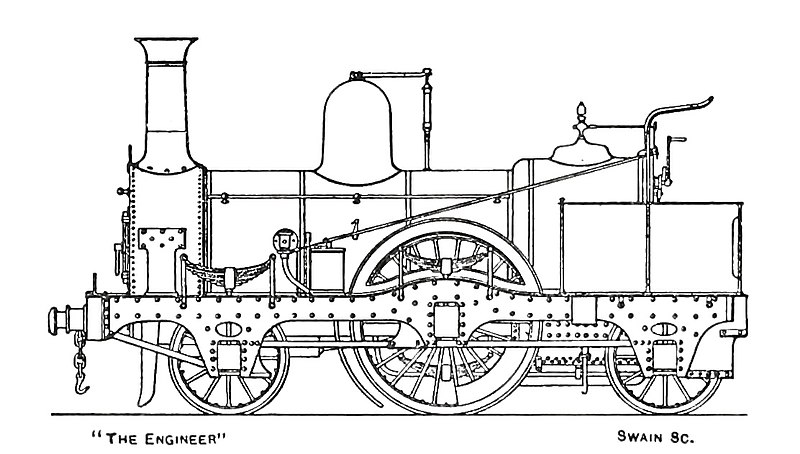File:Midland Railway 2-2-2 locomotive No 1, built by M. Kirtley in 1859 – Enhanced version, no caption, black and white.jpg

Original file (1,112 × 631 pixels, file size: 306 KB, MIME type: image/jpeg)
Captions
Captions
Summary[edit]
| DescriptionMidland Railway 2-2-2 locomotive No 1, built by M. Kirtley in 1859 – Enhanced version, no caption, black and white.jpg |
English: Midland Railway 2-2-2 express locomotive No 1, built in 1859 as part of a series of locomotives designed by M. Kirtley and built at the Midland Railway’s Derby facilities from 1856 till 1861. Locomotive shown as it appeared after being fitted with a cab (1863 or later). Image is a scan of: |
| Date |
before 1927 date QS:P,+1927-00-00T00:00:00Z/7,P1326,+1927-00-00T00:00:00Z/9 |
| Source | https://archive.org/stream/britishsteamrail00ahro/britishsteamrail00ahro#page/113/mode/1up |
| Author | Unknown authorUnknown author |
| Other versions |
|
Licensing[edit]
| Public domainPublic domainfalsefalse |
This work is in the public domain in the United States because it was published in the United States between 1929 and 1977, inclusive, without a copyright notice. For further explanation, see Commons:Hirtle chart as well as a detailed definition of "publication" for public art. Note that it may still be copyrighted in jurisdictions that do not apply the rule of the shorter term for US works (depending on the date of the author's death), such as Canada (50 p.m.a.), Mainland China (50 p.m.a., not Hong Kong or Macao), Germany (70 p.m.a.), Mexico (100 p.m.a.), Switzerland (70 p.m.a.), and other countries with individual treaties.
العربية ∙ беларуская (тарашкевіца) ∙ čeština ∙ Deutsch ∙ Ελληνικά ∙ English ∙ español ∙ français ∙ Bahasa Indonesia ∙ italiano ∙ 日本語 ∙ 한국어 ∙ македонски ∙ Nederlands ∙ português ∙ русский ∙ sicilianu ∙ slovenščina ∙ ไทย ∙ Tiếng Việt ∙ 中文(简体) ∙ 中文(繁體) ∙ +/− |
| Public domainPublic domainfalsefalse |
This UK artistic or literary work, of which the author is unknown and cannot be ascertained by reasonable enquiry, is in the public domain because it is one of the following:
|
(For details on the licensing, see File:Midland Railway 4-2-0 Crampton Locomotive No 131 built by Kitson, Thompson & Hewitson in 1848 – With caption.jpg.)
File history
Click on a date/time to view the file as it appeared at that time.
| Date/Time | Thumbnail | Dimensions | User | Comment | |
|---|---|---|---|---|---|
| current | 17:42, 13 March 2020 |  | 1,112 × 631 (306 KB) | Alias Sobriquet (talk | contribs) | Uploaded a work by {{unknown|author}} from https://archive.org/stream/britishsteamrail00ahro/britishsteamrail00ahro#page/113/mode/1up with UploadWizard |
You cannot overwrite this file.
File usage on Commons
The following 4 pages use this file:
- User:Mattbuck/Railways/2020 March
- File:Midland Railway 2-2-2 locomotive No 1, built by M. Kirtley in 1859 – Enhanced version, no caption, black and white.jpg
- File:Midland Railway 2-2-2 locomotive No 1, built by M. Kirtley in 1859 – Enhanced version, no caption.jpg
- File:Midland Railway 2-2-2 locomotive No 1, built by M. Kirtley in 1859 – Original version, with caption.jpg
Metadata
This file contains additional information such as Exif metadata which may have been added by the digital camera, scanner, or software program used to create or digitize it. If the file has been modified from its original state, some details such as the timestamp may not fully reflect those of the original file. The timestamp is only as accurate as the clock in the camera, and it may be completely wrong.
| Orientation | Normal |
|---|---|
| Horizontal resolution | 72 dpi |
| Vertical resolution | 72 dpi |
| Software used | QuickTime 7.7.1 |
| File change date and time | 18:14, 12 March 2020 |
| Exif version | 2.2 |




